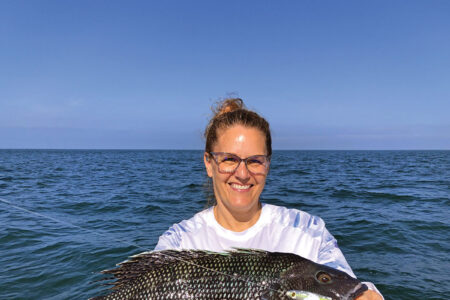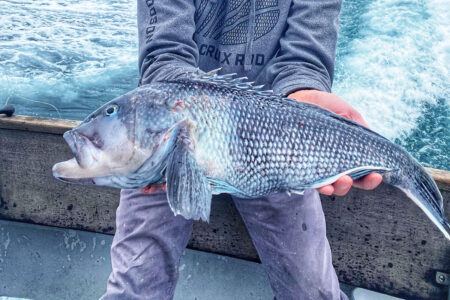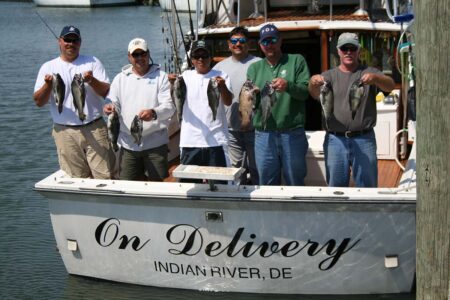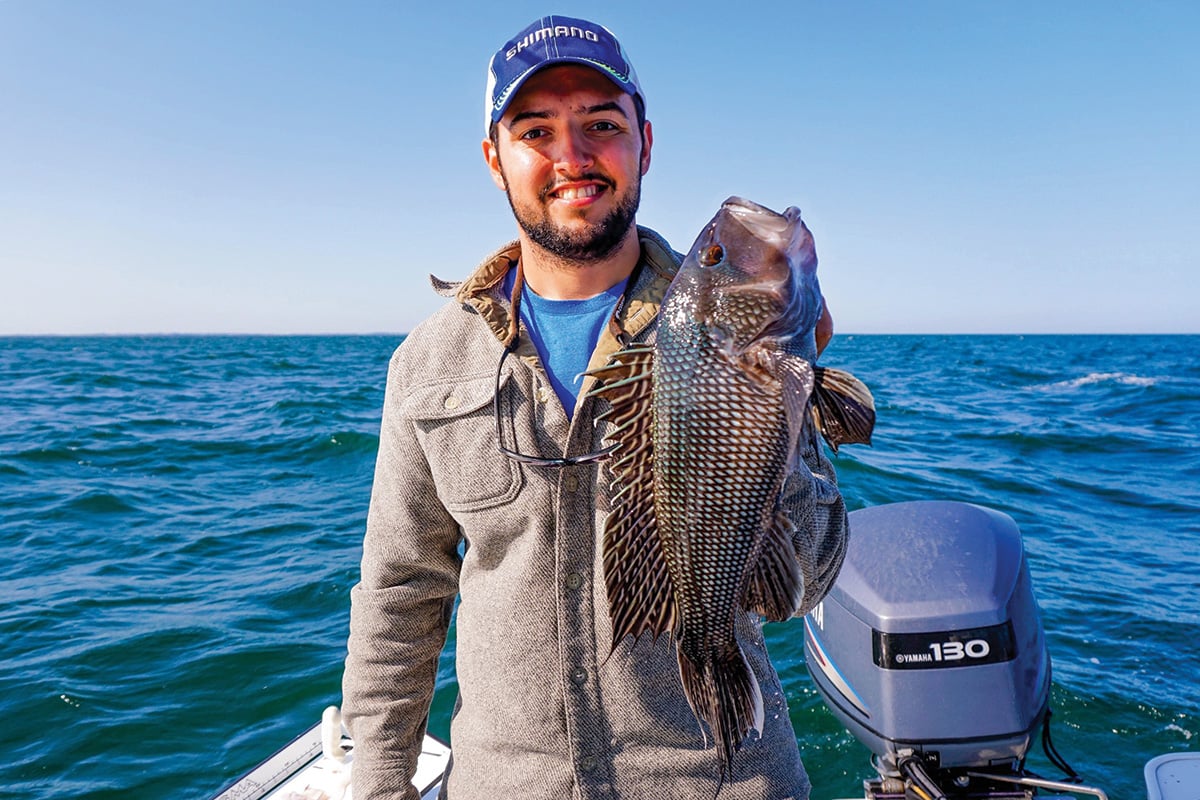
Water temperatures were rising, rod tips were bending, and the black sea bass season in New England was upon us! The sun had just peaked out over the horizon as we made our way out from the marina into Long Island Sound. Tackle shop whispers of aggressive sea bass hitting the local reefs and wrecks had us excited to make our first trip of the season. We pulled up on a popular early-season black sea bass hotspot and it wasn’t long before we were doubling-up on huge “knotheads.” Before we knew it, we had reached our two-man limit for the day and were grinning from ear to ear thinking about the resurgence of the black sea bass in our local waters. Years ago, days of sea bass fishing like this didn’t exist. But in recent years non-stop action and quality fish size have anglers grabbing their fishing gear and rushing to start the season with sea bass.
Black sea bass have earned a reputation as being a bottom fish. In the winter months these fish can be found deep in the ocean clinging to structure in depths of 200 feet or more. Once spring arrives, and water temperatures rise, these fish migrate back and into shallower inshore waters. May and June are the typical spawning months of the black sea bass. During this time of year fish are often found holding close to structure in 20 to 50 feet of water. Fish are aggressive in the spring, and although they are coined “bottom fish,” their aggressive nature will have them coming off the bottom to hit your presentation on its way through the water column.
Grabbing a map of the sea floor or checking the popular Navionics app are good places to start when searching for new spots to try for black sea bass. Fishing reefs, wrecks, and rocks should yield good results for catching these fish. If your first few drifts over an area don’t yield any bites, it is time to move on as active fish will readily give away their presence. Don’t waste your time fishing an unproductive area because it could be a long time before the tide changes and the fishing starts to become productive at that particular location.
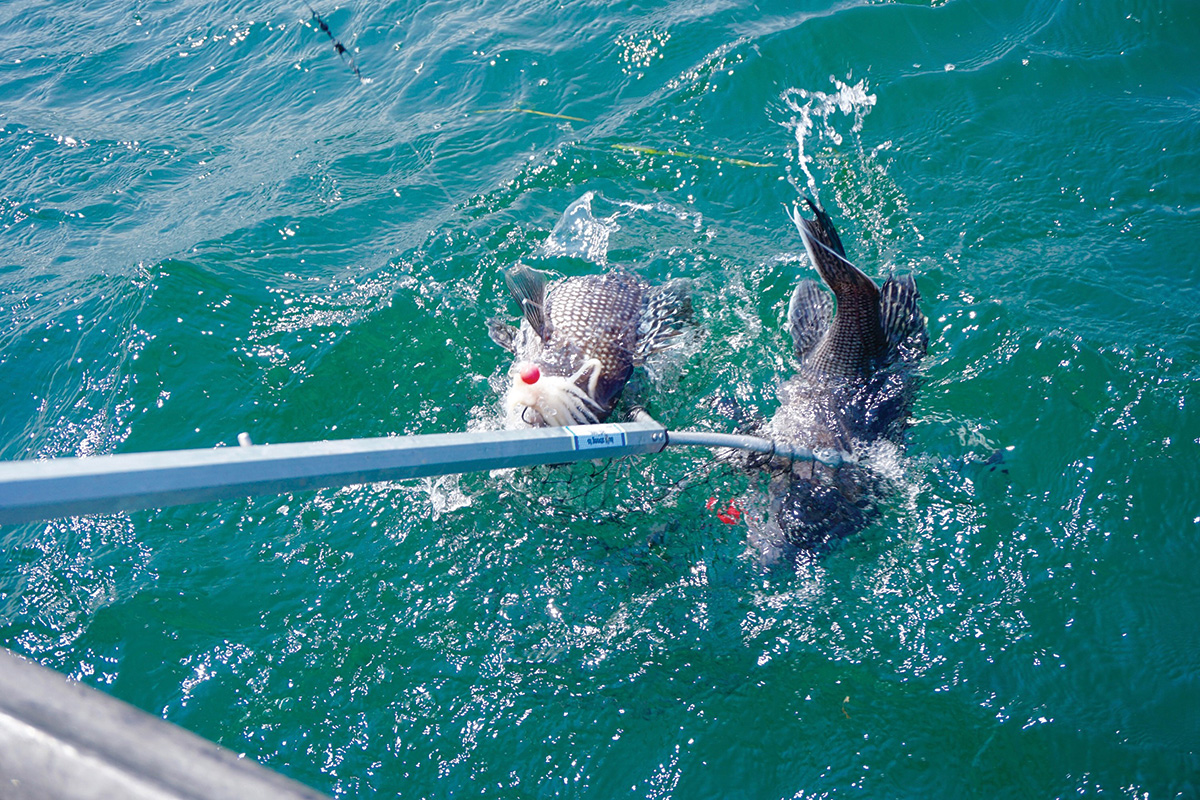
When fishing for sea bass don’t be afraid to try new spots and fish away from the fleet of boats in the area. Sea bass will hold to almost any structure from Long Island Sound to Southern Massachusetts. This gives anglers many options for productive spots and the opportunity to find your own sea bass “hot spot.” Studying your charts and depthfinder will also give you a better understanding of the habitat of a black sea bass and will have you catching more fish in no time.
When it comes to bottom fishing I find that many people use a set-up that is much too stout for their desired target. I use a medium-action rod between 6-1/2 and 7 feet long. The rod should have enough backbone to drive a hook into the fish’s mouth, yet be sensitive enough to feel the lightest of bites. Sea bass are generally known more for their excellent table fare than their fight. I believe this has less to do with the fight in the fish and more to do with the stout equipment used to catch them. Using a heavier rod and line will still yield results. However, when the bite is more particular and you find that your bait is regularly being stripped, a lighter rod helps combat these problems and allows you to feel the bite more easily.
Rod strength also depends on the depth that you are fishing. In the fall, the fish move deeper and a stouter rod paired with a heavier jig or sinker is necessary in order to hold bottom in those deeper spots with stronger currents. In the spring when fishing shallower structure, a lighter rod has you landing more fish, and you will find that sea bass are in fact a hard-fighting and aggressive fish worthy of not only tasty table fare, but excellent sport fishing as well.
When it comes to the choice of line, I almost exclusively fish with a braided main line and a fluorocarbon leader. Braided line has very little stretch, which makes it a top choice for most bottom fishing applications. This type of line allows you to feel the bite and drive the hook into the fish’s mouth with greater success. Fluorocarbon is one of the most popular leader materials in the bottom fishing game. It has very low visibility and helps you to get more bites and catch fish that may otherwise be “line shy” and finicky.
One of the most popular methods of sea bass fishing is called the high-low rig. This rig is a two-hook set up in which the hooks are placed one on top of another. A sinker is attached below the hooks keeping the rig in contact with the bottom while fishing. This rig is often fished with strips of squid on each hook. However, in recent years artificial soft baits are becoming more and more popular for this style of fishing. When sea bass are feeding aggressively, it is not uncommon for anglers to double-up on the high-low rig. These rigs can be purchased ready-to-fish at most bait shops, or they can be made at home where anglers are free to experiment with hook size and other variations to the set up.
Diamond jigs, bucktails, and epoxy jigs have also become popular methods of catching sea bass in recent years. These jigs can be tipped with strips of squid, artificial baits, or cast without the addition of any bait at all. This method of bottom fishing has become very popular in the spring when fish tend to be shallower, and smaller jigs can be fished more easily. When sea bass are feeding further up the water column these types of baits become very useful tools for anglers as they can be fished in a variety of different ways to entice fish to bite.
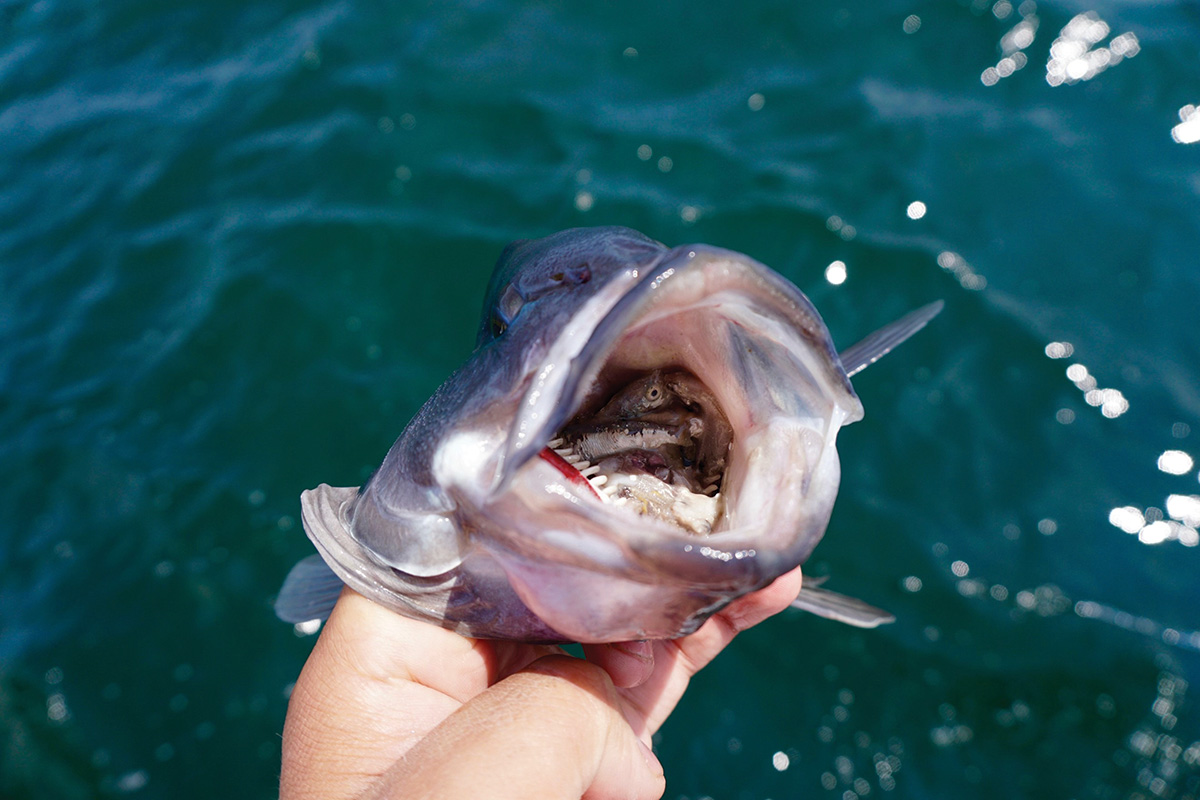
When fishing for spring sea bass I believe that drifting is your best option for catching more fish and better size fish. By drifting over a reef or wreck your presentation passes by more fish and gives you a better chance of connecting with a quality sea bass. This time of year, fish are very aggressive and it is not necessary to be anchored up dangling your bait over the fish, waiting for a bite. Some anglers get their bait to the bottom of the ocean floor and let it sit while they wait for a bite. I like to give the jig or bait some movement with light and quick “upticks” of the rod, enticing more sea bass to investigate the commotion. The resurgence of the black sea bass population has them feeding ferociously on reefs and wrecks. I believe that this feeding frenzy has them picking this type of structure clean and has the fish looking elsewhere for a food source.
One summer day last year, I was fishing at one of my favorite sea bass fishing holes only to see a flock of seagulls diving into the water up ahead of the structure. At first I thought the commotion was from bluefish or stripers, but as I got closer I realized that the action on the surface wasn’t that at all. I pitched an epoxy jig toward the commotion, and to my surprise I was almost immediately tight to a quality black sea bass! Fish showed on the electronics in the top half of the water column chasing small baitfish toward the surface. As this non-stop action was going on, I began to notice baby butterfish and peanut bunker scattered across the floor of the boat and in the cooler. Upon investigating inside the mouths of the many sea bass being caught, I noticed that they were packed full of these little fish. The aggressive nature of these sea bass had me switching from the more traditional bottom fishing rigs to casting toward the surface for them.
Sea bass are an ever-evolving fish that we learn more and more about each trip out, adapting our tactics and strategies to their behavior. So, as this fishing season begins, grab your sea bass gear and set out for these tasty and hard-fighting sport fish!
| BLACK SEA BASS LIFE HISTORY |
|---|
| Black sea bass (Centropristis striata) inhabit Atlantic coastal waters from the Gulf of Maine to the Florida Keys, concentrating in areas from Cape Cod, Massachusetts to Cape Canaveral, Florida. Two distinct stocks of black sea bass exist along the Atlantic coast with overlapping ranges. The northern stock migrates seasonally and spawns off of New England in the late summer. Black sea bass summer in northern inshore waters at depths of less than 120 feet and winter in southern offshore waters at depths of 240 to 540 feet.
Black sea bass are protogynous hermaphrodites, which mean they start life as a female and when they reach 9 to 13 inches (2 to 5 years of age) they change sex to become males. Thirty-eight percent of the females in the Mid-Atlantic demonstrate sex reversal between August and April, after most fish have spawned. Even though some fish are males when they reach sexual maturity, most produce eggs when they first mature. Following transition, a sea bass will either become a dominant male, characterized by a larger size and a bright blue nuchal hump during spawning season, or a subordinate male that has few distinguishing features. (Courtesy of the Atlantic States Marine Fisheries Council) |

